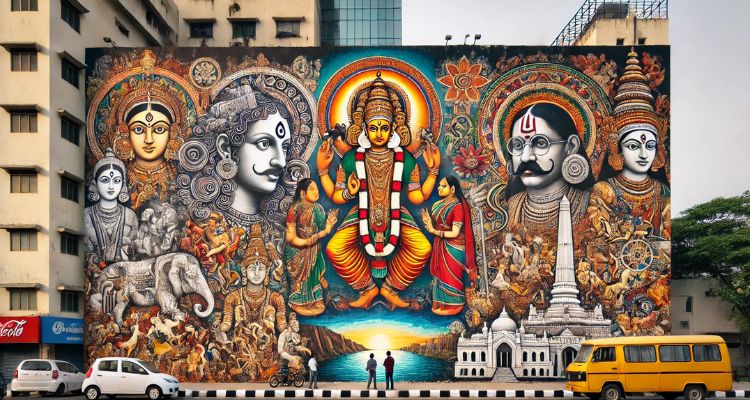Mural Painting is a powerful art form that transforms blank walls into breathtaking masterpieces. From ancient cave paintings to contemporary street art murals, this artistic tradition has evolved over centuries, embracing diverse styles, themes, and techniques. Whether found in temples, urban landscapes, or home interiors, mural arts captivate viewers with their vibrant storytelling and visual appeal.
What is Mural Art?
Mural art refers to paintings or artworks created directly on walls, ceilings, or other large permanent surfaces. These large mural wall art pieces often depict cultural heritage, historical narratives, or abstract expressions. Over time, mural wall art has become a popular medium for artists to convey social messages, beautify public spaces, and preserve traditional art forms.
The Evolution of Mural Painting
Mural Painting has a deep historical significance, spanning various cultures and civilizations. Ancient cave paintings in India, Egypt, and Europe depict early forms of mural art. Over the years, mural arts have transitioned from religious and historical themes to contemporary abstract art murals and large mural wall art that redefine modern aesthetics.

Ancient Mural Painting
The earliest forms of mural art date back thousands of years. In India, murals were found in the Ajanta and Ellora caves, depicting stories from Buddhist traditions. Egyptian murals adorned the walls of pyramids, while European cave paintings showed early depictions of human and animal life.

Medieval and Renaissance Mural Painting
During the medieval and Renaissance periods, mural paintings flourished in churches and palaces. Religious themes dominated, with murals narrating biblical stories and historical events. The Sistine Chapel ceiling by Michelangelo remains one of the greatest masterpieces of mural art.

Modern and Contemporary Murals
In the 20th and 21st centuries, mural paintings expanded beyond religious themes. Street art murals became a significant movement, with artists like Banksy using murals to communicate social and political messages. Abstract art murals and digital murals also became popular in modern homes and offices.
Types of Mural Painting
Mural paintings come in various forms, each with its unique characteristics and cultural significance. Some of the most popular types include:
1. Kerala Mural Art Paintings
One of India’s oldest mural traditions, Kerala mural art paintings are known for their intricate detailing and mythological themes. These paintings, primarily seen in temples and palaces, use natural pigments to create stunning depictions of Hindu deities and epics.

2. Abstract Art Murals
Abstract murals focus on shapes, colors, and forms rather than realistic depictions. These contemporary pieces are often seen in modern interiors and urban spaces, adding a dynamic aesthetic appeal.

3. Wallpaper Mural Art
For those who love the look of murals but prefer a more flexible option, wallpaper mural art is a fantastic alternative. These digitally printed murals replicate the beauty of hand-painted wall art and can be customized for homes, offices, and commercial spaces.

4. Street Art Murals
Street art murals have gained immense popularity in urban landscapes. Artists use public walls as canvases to express social, political, and cultural themes. These murals turn cities into open-air galleries, offering a unique blend of creativity and activism.

5. 3D Murals
3D mural paintings create an illusion of depth, making the artwork appear realistic. These murals are commonly found in theme parks, shopping malls, and interactive museums.

The Impact of Mural and Street Art
Mural and street art have a profound impact on communities, transforming dull spaces into vibrant cultural landmarks. They encourage artistic expression, create a sense of identity, and even boost local economies by attracting tourists and art enthusiasts.
Cultural Impact
Murals tell stories of history, traditions, and social movements. Many indigenous communities use murals to preserve their heritage and share their narratives with the world.
Economic Benefits
Mural paintings can increase tourism and business revenue. Cities known for their murals, such as Berlin, London, and Mexico City, attract thousands of visitors eager to explore street art.
Social Awareness and Activism
Artists often use mural art to spread messages about social justice, climate change, and human rights. Murals serve as a voice for communities and highlight critical global issues.
Benefits of Mural Wall Art
Mural Painting is more than just a decorative element; it offers numerous benefits:
- Enhances Aesthetic Appeal: Large mural wall art adds beauty and depth to any space.
- Personalized Expression: Art mural painting allows individuals to reflect their personality through custom designs.
- Promotes Cultural Heritage: Kerala mural art paintings and other traditional styles help preserve artistic traditions.
- Transforms Public Spaces: Street art murals revitalize urban areas, turning them into artistic hubs.
- Boosts Business Appeal: Commercial establishments use mural wall art to attract customers and create a unique brand identity.
How to Incorporate Mural Painting into Your Space
If you’re considering adding mural art to your home or business, here are some creative ways to incorporate it:
- Living Room Accent Wall: Abstract art murals add a modern touch to living spaces.
- Bedroom Serenity: Wallpaper mural art featuring nature scenes creates a calming environment.
- Commercial Branding: Businesses use large mural wall art to make a bold statement.
- Cultural Preservation: Traditional Kerala mural art paintings bring historical charm to temples and heritage buildings.
- Outdoor Murals: Street art murals can enhance the vibrancy of public areas and parks.
Mural Painting Techniques
Artists use various techniques to create stunning mural paintings, including:
- Fresco Painting: A traditional technique where pigments are applied to wet plaster, commonly seen in historical murals.
- Acrylic Mural Painting: A modern approach using fast-drying acrylic paints for vibrant and long-lasting effects.
- Spray Paint Murals: Popular among street artists, spray painting allows for quick and large-scale creations.
- Mixed Media Murals: Combining different materials like mosaic, glass, or digital elements for a unique visual effect.
Famous Mural Painting Around the World
Several iconic murals have left an indelible mark on art history. Some famous examples include:
- The Sistine Chapel Ceiling (Michelangelo, Vatican City): A masterpiece of Renaissance fresco painting.
- Diego Rivera’s Murals (Mexico): Powerful depictions of Mexican history and social themes.
- Banksy’s Street Art (Global): Provocative street murals with strong political messages.
- The Great Wall of Los Angeles (USA): A historical timeline painted along a massive wall in California.
- Bhimbetka Cave Paintings (India): Prehistoric murals dating back over 10,000 years.
The Future of Mural Art
As Mural Painting continues to evolve, technology plays a crucial role in its development. Digital murals and augmented reality (AR) murals are emerging trends that merge traditional techniques with modern innovation. These interactive murals allow viewers to engage with art in new and exciting ways.
Additionally, mural arts are increasingly being used for sustainability projects. Eco-friendly murals incorporate air-purifying paints that help reduce pollution, turning urban spaces into environmentally conscious art installations.
Conclusion
Mural painting is more than just an artistic endeavor; it is a celebration of culture, creativity, and history. Whether in the form of Kerala mural art paintings, abstract art murals, or wallpaper mural art, murals continue to inspire and captivate people worldwide. By embracing mural arts, we not only beautify spaces but also keep artistic traditions alive. Let your walls tell a story with the timeless charm of mural painting!
With its ability to merge history, modernity, and creative expression, mural art will undoubtedly continue to shape our visual landscape for generations to come. Whether you’re an artist, a business owner, or an art enthusiast, incorporating mural painting into your space is a rewarding experience that connects art with everyday life. For more information visit our website KalaSpot.com






